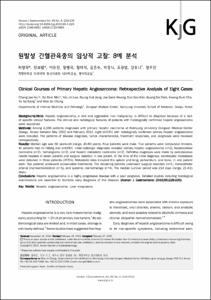KUMEL Repository
1. Journal Papers (연구논문)
1. School of Medicine (의과대학)
Dept. of Internal Medicine (내과학)
Clinical Courses of Primary Hepatic Angiosarcoma: Retrospective Analysis of Eight Cases
- Keimyung Author(s)
- Lee, Yoo Jin; Jang, Byoung Kuk; Hwang, Jae Seok; Kim, Eun Soo; Park, Kyung Sik; Cho, Kwang Bum; Chung, Woo Jin; Kang, Yu Na
- Journal Title
- Korean Journal of Gastroenterology
- Issued Date
- 2015
- Volume
- 65
- Issue
- 4
- Abstract
- Background/Aims: Hepatic angiosarcoma, a rare and aggressive liver malignancy, is difficult to diagnose because of a lack of specific clinical features. The clinical and radiological features of patients with histologically confirmed hepatic angiosarcoma were examined.
Methods: Among 2,336 patients diagnosed with primary hepatic carcinoma at Keimyung University Dongsan Medical Center(Daegu, Korea) between May 2002 and February 2012, eight (0.03%) with histologically confirmed primary hepatic angiosarcoma were included. The patterns of disease diagnosis, tumor characteristics, treatment responses, and prognoses were reviewed retrospectively.
Results: Median age was 66 years-old (range, 41-80 years). Four patients were male. Five patients were compulsive drinkers. All patients had no HBsAg and anti-HCV. Initial radiologic diagnoses revealed primary hepatic angiosarcoma (n=2), hepatocellular carcinoma (n=2), hemangioma (n=2), and hepatic metastatic carcinoma (n=2). Definitive diagnoses were made by percutaneous needle biopsies in seven patients and surgical resection in one patient. At the time of the initial diagnosis, extrahepatic metastases were detected in three patients (37.5%). Metastatic sites included the spleen and lung, pericardium, and bone, in one patient each. Two patients underwent conservative treatments. The remaining patients underwent surgical resection (n=1), transcatheter arterial chemoembolization (n=1), and systemic chemotherapy (n=4). The median survival period was 214 days (range, 21-431days).
Conclusions: Hepatic angiosarcoma is a highly progressive disease with a poor prognosis. Detailed studies including histological examinations are essential to facilitate early diagnosis of the disease.
- Alternative Title
- 원발성 간혈관육종의 임상적 고찰: 8예 분석
- Publisher
- School of Medicine
- Citation
- 정우진 et al. (2015). Clinical Courses of Primary Hepatic Angiosarcoma: Retrospective Analysis of Eight Cases. Korean Journal of Gastroenterology, 65(4), 229–235. doi: 10.4166/kjg.2015.65.4.229
- Type
- Article
- ISSN
- 1598-9992
- Appears in Collections:
- 1. School of Medicine (의과대학) > Dept. of Internal Medicine (내과학)
1. School of Medicine (의과대학) > Dept. of Pathology (병리학)
- 파일 목록
-
-
Download
 oak-bbb-2340.pdf
기타 데이터 / 2.91 MB / Adobe PDF
oak-bbb-2340.pdf
기타 데이터 / 2.91 MB / Adobe PDF
-
Items in Repository are protected by copyright, with all rights reserved, unless otherwise indicated.